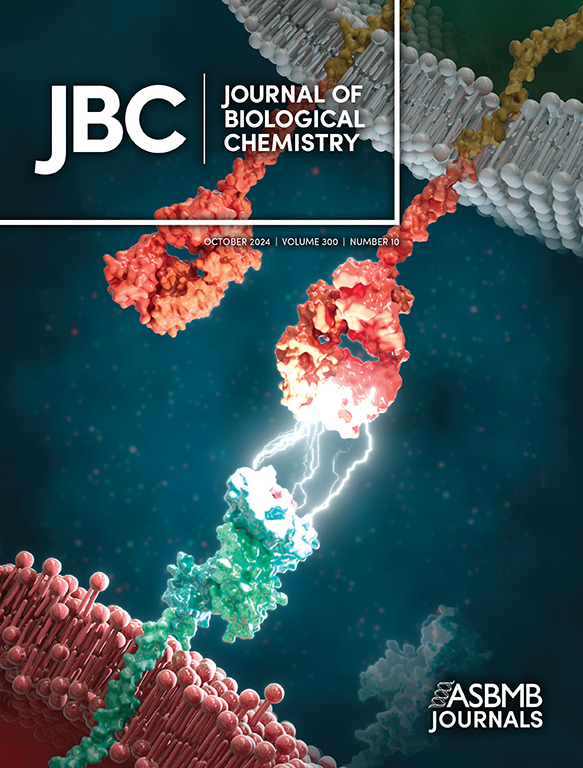SARS-CoV-2 Nsp15核糖核酸内酶抑制剂:噻唑烷二酮和罗丹宁类似物的建模、合成和酶促分析
IF 4
2区 生物学
Q2 BIOCHEMISTRY & MOLECULAR BIOLOGY
引用次数: 0
摘要
在感染过程中,冠状病毒Nsp15(一种尿嘧啶特异性核糖核酸内切酶)抑制宿主细胞的抗病毒反应。最近,研究人员更加关注这种相对未被充分开发但潜在可行的药物靶点。在这项研究中,我们采用基于荧光共振能量转移的筛选试验来鉴定有效的Nsp15抑制剂。随后,我们利用活性位点硅对接方法设计了具有增强抑制性能的新分子。溶液法测定这些抑制剂的效价并确定其作用机制。我们鉴定了一类新的噻唑烷二酮和罗丹宁类似物,可抑制SARS-CoV-2 Nsp15。将这些化合物与尿嘧啶结合位点对接表明,大多数类似物与Ser294形成两个氢键。抑制效果最好的是化合物KCO237和KCO251(半最大抑制浓度分别为0.304 μM和0.931 μM)。KCO237和KCO251的抑制动力学符合可逆混合抑制模型。突变Ser294并没有完全消除Nsp15的活性或KCO237或KCO251的抑制作用。这些发现表明,噻唑烷二酮和罗丹宁类似物可能通过结合尿嘧啶活性位点抑制Nsp15,同时也暗示可能存在次级变构结合位点。这些化合物在亚毒性水平上抑制VERO - 6细胞感染SARS-CoV-2的能力,突显了它们作为新型抗病毒治疗SARS-CoV-2和其他冠状病毒相关疾病的潜力。本文章由计算机程序翻译,如有差异,请以英文原文为准。
First-in-class inhibitors of Nsp15 endoribonuclease of SARS-CoV-2: modeling, synthesis, and enzymatic assay of thiazolidinedione and rhodanine analogs.
During infection, the coronavirus Nsp15, a uridine-specific endoribonuclease, suppresses the host cell's antiviral response. Recently, researchers have paid more attention to this relatively underexplored yet potentially viable drug target. In this study, we employed fluorescence resonance energy transfer-based screening assays to identify potent Nsp15 inhibitors. Subsequently, we used active-site in silico docking methods to design new molecules with enhanced inhibitory properties. Solution assays were used to measure the potency and determine the mechanism of these inhibitors. We identified a novel class of thiazolidinedione and rhodanine analogs that inhibit SARS-CoV-2 Nsp15. Docking these compounds into the uridine-binding site shows that most analogs form two hydrogen bonds with Ser294. The most potent inhibitors are compounds KCO237 and KCO251 (half-maximal inhibitory concentration: 0.304 μM, 0.931 μM respectively). The inhibition kinetics of KCO237 and KCO251 best align with a reversible mixed inhibition model. Mutating Ser294 did not completely abolish Nsp15 activity or the inhibitory effect of KCO237 or KCO251. These findings suggest that thiazolidinedione and rhodanine analogs likely inhibit Nsp15 by binding to the uridine active site while also implicating a possible secondary allosteric binding site. The ability of these compounds to inhibit VERO 6 cell infection with SARS-CoV-2 at subtoxic levels highlights their potential for development as novel antiviral treatments for SARS-CoV-2 and other coronavirus-related diseases.
求助全文
通过发布文献求助,成功后即可免费获取论文全文。
去求助
来源期刊

Journal of Biological Chemistry
Biochemistry, Genetics and Molecular Biology-Biochemistry
自引率
4.20%
发文量
1233
期刊介绍:
The Journal of Biological Chemistry welcomes high-quality science that seeks to elucidate the molecular and cellular basis of biological processes. Papers published in JBC can therefore fall under the umbrellas of not only biological chemistry, chemical biology, or biochemistry, but also allied disciplines such as biophysics, systems biology, RNA biology, immunology, microbiology, neurobiology, epigenetics, computational biology, ’omics, and many more. The outcome of our focus on papers that contribute novel and important mechanistic insights, rather than on a particular topic area, is that JBC is truly a melting pot for scientists across disciplines. In addition, JBC welcomes papers that describe methods that will help scientists push their biochemical inquiries forward and resources that will be of use to the research community.
 求助内容:
求助内容: 应助结果提醒方式:
应助结果提醒方式:


